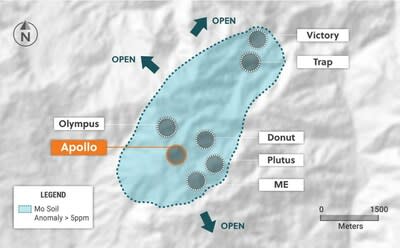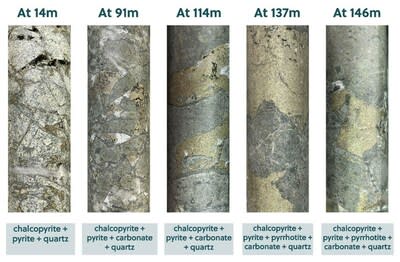- Drill hole APC-45, which is the first hole into the Contact Zone in the southernmost part of the Apollo porphyry system from Pad 7, intersected an abundance of sheeted CBM veins overprinting earlier porphyry mineralization. Remarkably continuous high-grade gold-silver-copper was intersected over the entire core length with results as follow:
- Hole APC-48 was drilled to the southwest from Pad 7 and successfully expanded the overall footprint of the shallow mineralization to the southwest. Interestingly, the hole exited the brecciated portion of the Apollo porphyry system and continued to the end of the interval in a mineralized precursor porphyry unit with overall results as follows:
- As a result of APC-48, the maximum known strike length of the system has increased to 435 metres (previously 385 metres) with the overall maximum known dimensions now measuring 435 metres strike x 385 metres width x 915 metres vertical. The system remains open for expansion in most directions.
- Hole APC-47 was drilled in an easterly direction from Pad 4 in order to cut across the system in an area of the block model with limited information. A long and continuous interval of high-grade gold-silver and copper mineralization was intersected with results as follows:
- Two drill holes, APC-49 and APC-55 were designed to explore the depth potential of the Apollo system from Pad 6 to the northeast and northwest respectively. Detailed visual logging of both holes indicates that long and continuous zones of mineralization were encountered from surface to downhole depths of 840 metres and 790 metres respectively. APC-49 was terminated while still in mineralization due to a drilling related issue while APC-55 will expand the over dimensions of the Apollo system to the northeast if it is mineralized to the end of the interval. Assay results for these holes are expected in late June 2023.
- Eleven additional holes have been completed at the Apollo system with assay results expected in the near term. All eleven holes intersected cumulative mineralization over varying yet significant downhole drill lengths. Three drill rigs are operating on site with a fourth rig expected to begin operating prior to the end of Q2, 2023. Once onsite, the fourth rig will focus on testing the six new exploration targets directly surrounding the Apollo system as well as regional targets within the three-kilometre porphyry corridor (see press release dated April 18, 2023, for further details).
Ari Sussman, Executive Chairman commented: “The Contact Zone at the Apollo system continues to intercept impressive high-grade mineralization and importantly can now be traced over a meaningful strike length. June 2023 is shaping up to be an exciting and important month for the Company with assay results expected for Contact Zone drill hole APC-53 and deep holes APC-49 and APC-55. Additionally, our aggressive exploration focus will expand with a fourth rig scheduled to arrive on site in late June. This rig will be designated to systematically test exploration targets surrounding the Apollo porphyry system and the greater Guayabales project.”
TORONTO, May 30, 2023 /CNW/ – Collective Mining Ltd. (TSXV: CNL) (OTCQX: CNLMF) (“Collective” or the “Company”) is pleased to announce assay results from a further three drill holes as well as visual observations for two long drill holes which tested the depth potential of the Apollo porphyry system (“Apollo”) at the Guayabales project located in Caldas, Colombia. Apollo is a high-grade, bulk tonnage copper-silver-gold system, which owes its excellent metal endowment to an older copper-silver and gold porphyry system being overprinted by younger precious metal rich, carbonate base metal vein systems (intermediate sulphidation porphyry veins) within a magmatic, hydrothermal inter-mineral breccia and diorite porphyry bodies currently measuring 435 metres x 395 metres x 915 metres and open for expansion.
Details (See Table 1 and Figures 1-3)
The 2023 Phase II drilling program is advancing on schedule with eighteen holes completed and results announced. A further eleven holes have been drilled and await assay results from the lab. The objectives of the 2023 program are to define high-grade mineralization, the dimensions of the Apollo porphyry system near surface, expand the size of the system through step-out and directional drilling and drill test multiple new targets generated through grassroots exploration. Since the announcement of the discovery hole at Apollo in June 2022, a total of 49 drill holes (approximately 21,487 metres) have been completed and assayed.
This press release outlines results from three holes. APC-45 and APC-48 were drilled in southerly and south westerly directions from Pad 7 while APC-47 was drilled to the east from Pad 4. APC-45 was designed to test the Contact Zone (where the intermineral breccia ends at a contact with quartz diorite porphyry) at shallow levels in the southern portion of the deposit. APC-48 was designed to test the mineralization potential in the porphyry host rock to the south of the Apollo system while APC-47 was designed to test a large void in the block model for the Apollo system. Additionally, visual observations are provided for two long holes, APC-49 and APC-55, which were drilled to the northwest and northeast respectively from Pad 6. Results for all holes are summarized below:
APC-45 was drilled steeply (-85°) in a southerly direction from Pad 7 to a maximum downhole depth of 238.4 metres and was designed to test the Contact Zone between breccia and porphyry host units as well as the high-grade copper mineralization previously encountered at shallow levels in this area. The mineralized interval of oxidation (saprolite) commenced from surface to 17.05 metres and was then followed by a transition zone to 39.55 metres down hole. The transition zone hosts iron oxides formed from the oxidation of the original sulphides hosted within the matrix of the breccia and within veins. Below the zone of oxidation, the intercept passed into fresh rock consisting of mineralised quartz diorite breccia with a sulphide matrix composition of 1.5% chalcopyrite, pyrite up to 5% and pyrrhotite (up to 3.0%). Continuous mineralization was encountered until 162.20 metres (160 metres vertical). A high-grade zone of carbonate base metal veins (“CBM veins”) was intercepted from just below the transition zone until 54 metres depth. Notably, exceptional and continuous mineralization was intercepted along the interval with grades increasing as the hole approached the physical contact between breccia and quartz diorite porphyry The Contact Zone contains excellent gold, silver and copper grades associated with the sulphide matrix and overprinting quartz-carbonate and sulphide veining with complete assay results for the hole as follows:
- 162.20 metres @ 3.90 g/t gold equivalent commencing from surface (consisting of 2.59 g/t gold, 29 g/t silver and 0.56% copper) and including:
APC-47 was drilled in an easterly direction from Pad 4 to a maximum downhole depth of 636.3 metres and was designed to test multiple zones of CBM veins overprinting the mineralized breccia in the central eastern side of the deposit where limited information was available in the block model. The drill hole intercepted porphyry mineralization with CBM sheeted veins overprinting in part at shallow downhole depths before passing into mineralized breccia at a downhole depth of 226.80 metres (220 metres vertical). Continuous porphyry mineralization with overprinting sheeted CBM vein material was observed in the breccia until 534.40 metres downhole. The mineralized breccia’s sulphide matrix hosts chalcopyrite (1%), pyrite (1%-2.5%) plus some pyrrhotite with multiple zones of sphalerite and galena observed. Three principal high-grade zones were intersected at downhole depths of 233.15 metres to 261.50 metres, 354.40 metres to 372.20 metres and 396.00 metres to 413.10 metres with assay results for the complete hole as follows:
- 307.60 metres @ 2.53 g/t gold equivalent from 226.80 metres downhole (consisting of 1.40 g/t gold, 53 g/t silver and 0.25% copper) including:
APC-48 was drilled steeply (-75°) in a southwesterly direction from Pad 7 to a maximum downhole depth of 354.55 metres and was designed to test the potential of mineralization outside of the breccia to the southwest. The mineralized interval of oxidation commenced from surface to 12.40 metres and consists of saprolite followed by a transition zone down to 39.55 metres. The transition zone hosts iron oxides formed from the oxidation of the original sulphides hosted within the matrix of the breccia and within veins. Below the zone of oxidation, the intercept passed into fresh rock consisting of quartz diorite breccia with a matrix of chalcopyrite (0.8%), pyrite (up to 2.5%) and 1% pyrrhotite. A high-grade zone was encountered within the transition zone from 13.15 metres to 31.40 metres downhole with numerous sheeted CBM veins overprinting the breccia matrix. APC-48 exited the mineralized breccia at 114.40 metres (112 metres vertical) and entered a mineralized precursor stage of porphyry mineralization from 128.10 metres to 236.70 metres grading 0.40 g/t gold equivalent over 108.60 metres. APC-48 is notable for extending the maximum known strike length of the Apollo system by 50 metres to the southwest with the maximum known overall system dimensions now measuring 435 metres x 395 metres x 915 metres. Assay results for APC-48 are as follows:
- 114.40 metres @ 2.38 g/t gold equivalent commencing from surface (consisting of 1.71 g/t gold, 15 g/t silver and 0.29% copper) and including:
Visual Observations for Drill Holes APC-49 and APC-55 (see Figure 1)
Two step out drill holes were recently completed from Pad 6. APC-49 was drilled to the northwest and encountered over 840 metres of continuous, downhole mineralization from surface. The hole contains an upper zone rich in chalcopyrite (up to 1.5%) to 300 metres downhole and below that multiple zones with overprinting CBM veins were encountered. The hole was stopped at 852.90 metres (900 metres vertical) while still in mineralized breccia due to drilling related challenges.
Drill hole APC-55 was drilled to the northeast from Pad 10 and also intersected continuous mineralization from surface to a downhole depth of 790 metres (752 metres vertical). The upper portion of the intercept (to 400 metres downhole depth) contains strong chalcopyrite mineralization of up to 1.5% in the breccia matrix as well as overprinting CBM veins. Below 400 metres, the hole continues in mineralized breccia including various zones of sulphide rich CBM veins and veinlets containing high amounts of sphalerite and galena. APC-55 has the potential to extend the Apollo porphyry system to the northeast and again highlights the presence of multiple CBM zones in the northeast and eastern sector of the Apollo deposit below the copper rich zone. The Company plans to undertake directional drilling in this area.
Apollo Drill Program
Eleven additional holes have been completed at the Apollo system with assay results expected in the near term. All holes intersected bulk tonnage mineralization over significant core lengths.
The Company presently has three diamond drill rigs operating at the Apollo project. A fourth drill rig is expected to be at the project in June 2023 and is going to test new exploration targets identified around Apollo as well as other targets at the Guayabales project.
The Apollo target area, as defined to date by surface mapping, rock sampling and copper and molybdenum soil geochemistry covers a 1,000 metres X 1,200 metres area and represents a large and unusually high-grade Cu-Ag-Au porphyry system. Mineralization styles include early-stage porphyry veins, inter-mineral breccia mineralization and multiple zones of porphyry related late stage, sheeted, carbonate-base metal veins with high gold and silver grades. The Apollo target area is still expanding as the Company’s geologists have found multiple additional outcrop areas with porphyry veining, breccia, and late stage, sheeted, carbonate base metal veins. (see press release dated April 18, 2023)
Table 1: Assay Results APC-45, APC-47 and APC-48
| Hole # | From(m) | To(m) | InterceptInterval (m) | Au(g/t) | Ag(g/t) | Cu% | Mo% | AuEq(g/t)* | CuEq(%)* | Notes |
| APC-45 | – | 162.20 | 162.20 | 2.59 | 29 | 0.56 | 0.003 | 3.90 | 2.08 | |
| Incl | – | 17.05 | 17.05 | 3.13 | 16 | 0.13 | 0.001 | 3.50 | oxide + transition zone | |
| 17.05 | 54.00 | 36.95 | 4.93 | 7 | 0.11 | 0.003 | 5.08 | |||
| 127.90 | 155.00 | 27.10 | 4.20 | 54 | 1.09 | 0.003 | 6.70 | Contact Zone | ||
| APC-47 | 21.00 | 49.25 | 28.25 | 0.77 | 10 | 0.93 | mineralization in porphyry | |||
| 100.95 | 108.75 | 7.80 | 0.92 | 8 | 1.03 | mineralization in porphyry | ||||
| APC-47 | 226.80 | 534.40 | 307.60 | 1.40 | 53 | 0.25 | 0.001 | 2.53 | 1.35 | |
| Incl | 233.15 | 261.50 | 28.35 | 3.84 | 65 | 0.24 | 0.001 | 5.06 | ||
| 354.40 | 372.20 | 17.80 | 4.19 | 42 | 0.09 | 0.001 | 4.81 | |||
| 396.00 | 413.10 | 17.10 | 5.19 | 90 | 0.19 | 0.001 | 6.62 | |||
| APC-48 | – | 236.70 | 236.70 | 0.90 | 11 | 0.17 | 0.003 | 1.35 | ||
| Incl | – | 114.40 | 114.40 | 1.71 | 15 | 0.29 | 0.003 | 2.38 | 1.27 | |
| – | 12.40 | 12.40 | 1.27 | 10 | 0.15 | 0.002 | 1.65 | oxide + transition zone | ||
| 13.15 | 31.40 | 18.25 | 5.90 | 17 | 0.20 | 0.002 | 6.32 | |||
| And incl | 128.10 | 236.70 | 108.60 | 0.16 | 8 | 0.06 | 0.004 | 0.40 | mineralization in porphyry |
| *AuEq (g/t) is calculated as follows: (Au (g/t) x 0.97) + (Ag g/t x 0.016 x 0.88) + (Cu (%) x 1.87 x 0.90)+ (Mo (%)*11.43 x 0.85) and CuEq (%) is calculated as follows: (Cu (%) x 0.90) + (Au (g/t) x 0.51 x 0.97) + (Ag (g/t) x 0.009 x 0.88)+ (Mo(%)x 6.10 x 0.85) utilizing metal prices of Cu – US$4.10/lb, Ag – $24/oz Mo – US$25.00/lb and Au – US$1,500/oz and recovery rates of 97% for Au, 88% for Ag, 85% for Mo, and 90% for Cu. Recovery rate assumptions are speculative as limited metallurgical work has been completed to date. A 0.2 g/t AuEq cut-off grade was employed with no more than 15% internal dilution. True widths are unknown, and grades are uncut. |


About Collective Mining Ltd.
To see our latest corporate presentation and related information, please visit www.collectivemining.com
Founded by the team that developed and sold Continental Gold Inc. to Zijin Mining for approximately $2 billion in enterprise value, Collective Mining is a copper, silver, and gold exploration company with projects in Caldas, Colombia. The Company has options to acquire 100% interests in two projects located directly within an established mining camp with ten fully permitted and operating mines.
The Company’s flagship project, Guayabales, is anchored by the Apollo target, which hosts the large-scale, bulk-tonnage and high-grade copper-silver-gold Apollo porphyry system. The Company’s near-term objective is to drill the shallow portion of the porphyry system while continuing to expand the overall dimensions of the system, which remains open in most directions.
Management, insiders and close family and friends own nearly 45% of the outstanding shares of the Company and as a result, are fully aligned with shareholders. The Company is listed on the TSXV under the trading symbol “CNL” and on the OTCQX under the trading symbol “CNLMF”.
Qualified Person (QP) and NI43-101 Disclosure
David J Reading is the designated Qualified Person for this news release within the meaning of National Instrument 43-101 (“NI 43-101”) and has reviewed and verified that the technical information contained herein is accurate and approves of the written disclosure of same. Mr. Reading has an MSc in Economic Geology and is a Fellow of the Institute of Materials, Minerals and Mining and of the Society of Economic Geology (SEG).
Technical Information
Rock, soils and core samples have been prepared and analyzed at SGS laboratory facilities in Medellin, Colombia and Lima, Peru. Blanks, duplicates, and certified reference standards are inserted into the sample stream to monitor laboratory performance. Crush rejects and pulps are kept and stored in a secured storage facility for future assay verification. No capping has been applied to sample composites. The Company utilizes a rigorous, industry-standard QA/QC program.
Information Contact:
Follow Executive Chairman Ari Sussman (@Ariski73) and Collective Mining (@CollectiveMini1) on Twitter.
FORWARD-LOOKING STATEMENTS
This news release contains certain forward-looking statements, including, but not limited to, statements about the drill programs, including timing of results, and Collective’s future and intentions. Wherever possible, words such as “may”, “will”, “should”, “could”, “expect”, “plan”, “intend”, “anticipate”, “believe”, “estimate”, “predict” or “potential” or the negative or other variations of these words, or similar words or phrases, have been used to identify these forward-looking statements. These statements reflect management’s current beliefs and are based on information currently available to management as at the date hereof.
Forward-looking statements involve significant risk, uncertainties, and assumptions. Many factors could cause actual results, performance, or achievements to differ materially from the results discussed or implied in the forward-looking statements. These factors should be considered carefully, and readers should not place undue reliance on the forward-looking statements. Although the forward-looking statements contained in this news release are based upon what management believes to be reasonable assumptions, Collective cannot assure readers that actual results will be consistent with these forward-looking statements. These forward-looking statements are made as of the date of this news release, and Collective assumes no obligation to update or revise them to reflect new events or circumstances, except as required by law.
Neither the TSXV nor its Regulation Services Provider (as that term is defined in the policies of the TSXV) accepts responsibility for the adequacy or accuracy of this news release.







